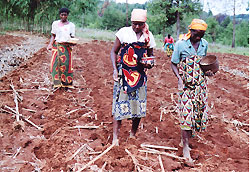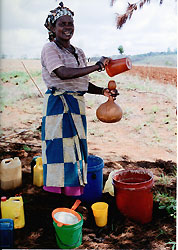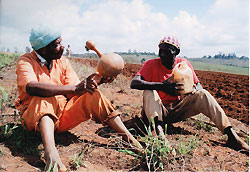| Period: 24 October - 23 December
2003. Country: Tanzania |
|
(1) Agro-Ecological
Study on the Transformation of Indigenous Agriculture under Socio-Economic Influences
in the Southern Highlands of Tanzania |
| KONDO
Fumi (Division of African Area Studies) |
| Key Words: East
Africa, Indigenous Agriculture, Transformation of Subsistence Activity,
Valley-Bottom Cultivation, Agroforestry |

A scene of chama (seeding) |

Organizer of mgowe entertains participants to local beer.
Each participant brings a bottle for beer
|

After mgowe work: relaxing with local beer |
(2) The Bena
are farmers who inhabit the southern highlands of Tanzania in East Africa. They
employ a unique valley bottom cultivation system called fiyungu in the dry season,
while at the same time using hillside fields in the rainy season. This combined
cultivation system provides them with staple household food security throughout
the year. Historically, they practiced slash-and-burn agriculture using both
types of fields. Over the years, they have improved their own agricultural technologies
and created a new cultivation system that fits the present macro socioeconomic
conditions of Tanzania. At present, the new cultivation system provides them
not only with staple food security, but also with cash earnings.
The main objectives
of this study are as follows: 1) To clarify how the new cultivation system was
created, and analyze its influences on the ecosystem and its sustainability.
2) To evaluate the socioeconomic influence of this new cultivation system on
Bena society.
(3) From
Oct. 24, 2003 to Dec. 23, 2003, I conducted my fieldwork in a rural Bena village
(Iringa region, Njombe District, Kifanya village). Through the research, I clarified
the actual situation of 1) the group work of agricultural activities, and 2)
the lending or borrowing of formerly afforested land.
- Group work in the research area can be roughly classified into two types.
The first is a traditional form of cooperative work, called hisambula or mugowe
locally, in which participants are entertained with local beer. The members
of the hisambula or mugowe vary from occasion to occasion. However, in each
case the labor force is counted as something like debt. This exchange of labor
force is conducted not only between work of the same kind, but also between
work of different kinds. The second type of group work is rotation work, without
the provision of beer, called chama locally, which was started under the socialistic
agricultural policy after the independence of Tanzania in 1961. In one rotation
period of chama, the members of the group are fixed, and the exchange of labor
force is conducted between work of the same kind.
- Nowadays, the Bena plant trees in fallow fields, fell them for use as
charcoal or lumber after 10 to 20 years, and burn the remaining branches and
leaves as part of slash-and-burn cultivation. However, as a result of the villagization
which led to the concentration of the population into villages, the size of
afforested fields varies greatly among households. The lending and borrowing
of formerly
afforested fields between immigrants and former inhabitants is very common.
Based on these findings, I will evaluate the relationship between the changes
in the Bena cultivation system and their society.
|



 21st Century COE Program
-Aiming for COE of Integrated Area Studies-
21st Century COE Program
-Aiming for COE of Integrated Area Studies-